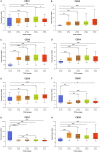Evaluation of the prognostic value of CBXs in gastric cancer patients
- PMID: 34117289
- PMCID: PMC8196000
- DOI: 10.1038/s41598-021-91649-7
Evaluation of the prognostic value of CBXs in gastric cancer patients
Abstract
Chromobox (CBX) proteins were suggested to exert epigenetic regulatory and transcriptionally repressing effects on target genes and might play key roles in the carcinogenesis of a variety of carcinomas. Nevertheless, the functions and prognostic significance of CBXs in gastric cancer (GC) remain unclear. The current study investigated the roles of CBXs in the prognosis of GC using the Oncomine, The Gene Expression Profiling Interactive Analysis (GEPIA), UALCAN, The Cancer Genome Atlas (TCGA), and cBioPortal databases. CBX1/2/3/4/5 were significantly upregulated in GC tissues compared with normal tissues, and CBX7 was downregulated. Multivariate analysis showed that high mRNA expression levels of CBX3/8 were independent prognostic factors for prolonged OS in GC patients. In addition, the genetic mutation rate of CBXs was 37% in GC patients, and genetic alterations in CBXs showed no association with OS or disease-free survival (DFS) in GC patients. These results indicated that CBX3/8 can be prognostic biomarkers for the survival of GC patients.
Conflict of interest statement
The authors declare no competing interests.
Figures




References
Publication types
MeSH terms
Substances
LinkOut - more resources
Full Text Sources
Medical
Miscellaneous

